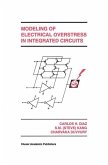Electrothermal Analysis of VLSI Systems addresses electrothermal problems in modern VLSI systems.
Part I, The Building Blocks, discusses electrothermal phenomena and the fundamental building blocks that electrothermal simulation requires (including power analysis, temperature-dependent device modeling, thermal/electrothermal simulation, and experimental setup-calibration).
Part II, The Applications, discusses three important applications of VLSI electrothermal analysis including temperature-dependent electromigration diagnosis, cell-level thermal placement and temperature-driven power and timing analysis.
Electrothermal Analysis of VLSI Systems will be useful for researchers in the fields of IC reliability analysis and physical design, as well as VLSI designers and graduate students.
Part I, The Building Blocks, discusses electrothermal phenomena and the fundamental building blocks that electrothermal simulation requires (including power analysis, temperature-dependent device modeling, thermal/electrothermal simulation, and experimental setup-calibration).
Part II, The Applications, discusses three important applications of VLSI electrothermal analysis including temperature-dependent electromigration diagnosis, cell-level thermal placement and temperature-driven power and timing analysis.
Electrothermal Analysis of VLSI Systems will be useful for researchers in the fields of IC reliability analysis and physical design, as well as VLSI designers and graduate students.
From the Foreword:
`Continuing increases in the levels of circuit integration and concomitant increases in performance are sustaining the trend of increasing power dissipation in VLSI systems. A consequence is that the impact of temperature on the successful operation and reliability of devices must be comprehended during the design process.....This text provides a comprehensive formulation of the electrothermal analysis problem beginning with a summary of the sources of power dissipation in CMOS circuits and followed by a formulation of the effect of temperature on MOS devices.'
Dr. Ralph K. Cavin, Vice President, Semiconductor Research Corporation
`Continuing increases in the levels of circuit integration and concomitant increases in performance are sustaining the trend of increasing power dissipation in VLSI systems. A consequence is that the impact of temperature on the successful operation and reliability of devices must be comprehended during the design process.....This text provides a comprehensive formulation of the electrothermal analysis problem beginning with a summary of the sources of power dissipation in CMOS circuits and followed by a formulation of the effect of temperature on MOS devices.'
Dr. Ralph K. Cavin, Vice President, Semiconductor Research Corporation
From the Foreword:
`Continuing increases in the levels of circuit integration and concomitant increases in performance are sustaining the trend of increasing power dissipation in VLSI systems. A consequence is that the impact of temperature on the successful operation and reliability of devices must be comprehended during the design process.....This text provides a comprehensive formulation of the electrothermal analysis problem beginning with a summary of the sources of power dissipation in CMOS circuits and followed by a formulation of the effect of temperature on MOS devices.'
Dr. Ralph K. Cavin, Vice President, Semiconductor Research Corporation
`Continuing increases in the levels of circuit integration and concomitant increases in performance are sustaining the trend of increasing power dissipation in VLSI systems. A consequence is that the impact of temperature on the successful operation and reliability of devices must be comprehended during the design process.....This text provides a comprehensive formulation of the electrothermal analysis problem beginning with a summary of the sources of power dissipation in CMOS circuits and followed by a formulation of the effect of temperature on MOS devices.'
Dr. Ralph K. Cavin, Vice President, Semiconductor Research Corporation








